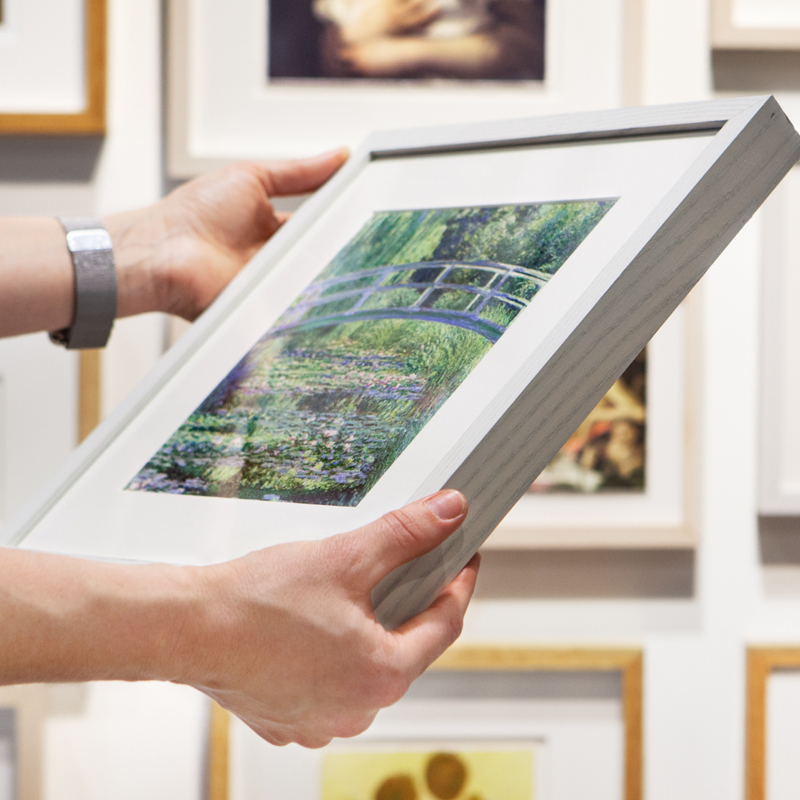Vincent van Gogh, 'Van Gogh's Chair', 1888
About the work
Overview
This painting of a simple chair set on a bare floor of terracotta tiles is one of Van Gogh’s most iconic images. It was painted in late 1888, soon after fellow artist Paul Gauguin had joined him in Arles in the south of France. The picture was a pair to another painting, Gauguin’s Chair (Van Gogh Museum, Amsterdam). They were to be hung together, with one chair turned to the right, the other to the left.
Both chairs function as surrogate portraits, representing the personalities and distinct artistic outlooks of the two artists. While Van Gogh’s chair is simple and functional, Gauguin’s is an elegant and finely carved armchair. Van Gogh’s chair, on which he placed his pipe and tobacco, is shown in bright daylight. Gauguin’s, with two novels on its seat, was painted at night and is illuminated by a candle and gas light.
Audio description
Listen to an audio description of Vincent van Gogh's 'Van Gogh's Chair'
Transcript
This is a description of 'Van Gogh’s Chair' painted by Vincent van Gogh. It is in oils, almost one metre high and 73 cm wide, with a broad, oak frame.
On completing the painting in November 1888, Van Gogh described it in a letter to his brother Theo simply as: “a wooden and straw chair all yellow on red tiles against a wall”.
The picture shows a single empty chair, set at a 45-degree turn to our right. The chair is in different shades of bright yellows. Its design is simple and rustic, robust with chunky legs. It has no arms, three horizontal slats at the back and a seat of straw, woven in sections towards its centre. Painted as if we are looking down on it, it almost fills the height of the composition.
The colours are vibrant and bold. Behind the chair, a wall of pale aqua blue meets the floor in a diagonal line, from the left, down to the right. Here, a darker turquoise blue suggests the lower corner of a door. The warm yellow hues of the chair are in striking contrast with the cool wall, and the tiled floor of terracotta tiles, reddish browns of chocolate and rust colours, with some pink.
Thick oil paint has been applied with a loaded brush, leaving raised paint on the surface. A criss-cross pattern of interwoven brushstrokes gives texture to the wall and floor. Broad brushstrokes of the lightest lemon-yellow follow the length of chair legs, and the struts in between.
The entire chair is outlined by a single line of cornflower blue. More pale lines on the floor, divide the staggered rectangles of the large floor tiles. These run in unexpected directions which disrupts the sense of space within the painting.
Reminding us of the artist who would ordinarily sit here, an abandoned tobacco pipe is on the seat, next to the jagged shape of a crumpled tobacco pouch. There is a profound sense of presence suggested by this lone, empty chair. Or an absence.
Behind the chair, to the left, is part of an open wooden crate on the floor – cut off by the edge of the painting. Here the artist has signed his name: simply, ‘Vincent’. Inside the box are what appears to be sprouting onions.
Van Gogh painted another picture of a chair at the same time as this one, designed to hang alongside it. It is now in the Van Gogh Museum in Amsterdam. In contrast, the second chair is in a dark room at night-time, lit by a candle on a stack of books. For Van Gogh, it represented his friend and fellow artist, Paul Gauguin and the differences in the two men’s approaches to art and life.
In this painting, this everyday object is a representation of Van Gogh’s personality and the qualities he valued: simplicity, and directness. A humble chair, in a shadowless room, its colours enlivened by the clarity of natural daylight.
It is the painting’s ability to express the character of its maker, which has led to it becoming one of Van Gogh’s best-loved paintings.
Key facts
Details
- Full title
- Van Gogh's Chair
- Artist
- Vincent van Gogh
- Artist dates
- 1853 - 1890
- Date made
- 1888
- Medium and support
- oil on canvas
- Dimensions
- 91.8 × 73 cm
- Inscription summary
- Signed
- Acquisition credit
- Bought, Courtauld Fund, 1924
- Inventory number
- NG3862
- Location
- Room 43
- Collection
- Main Collection
- Frame
- 17th-century Italian Frame
Provenance
Additional information
Text extracted from the ‘Provenance’ section of the catalogue entry in Martin Davies, with additions and some revisions by Cecil Gould, ‘National Gallery Catalogues: French School: Early 19th Century, Impressionists, Post-Impressionists, etc.’, London 1970; for further information, see the full catalogue entry.
Exhibition history
-
2010The Real Van Gogh: The Artist and His LettersRoyal Academy of Arts23 January 2010 - 18 April 2010
-
2015Loan to the Fondazione Magnani RoccaFondazione Magnani Rocca24 September 2015 - 8 December 2015
-
2016Van Gogh's BedroomsThe Art Institute of Chicago14 February 2016 - 10 May 2016
-
2022Van Gogh. Self-PortraitsThe Courtauld Gallery3 February 2022 - 8 May 2022
-
2022Van Gogh in AmericaThe Detroit Institute of Arts2 October 2022 - 22 January 2023
-
2024Van Gogh: Poets and LoversThe National Gallery (London)14 September 2024 - 19 January 2025
Bibliography
-
1911H.P. Bremmer, Van Gogh, Amsterdam 1911
-
1923Leicester Galleries, Catalogue of an Exhibition of Works by Vincent Van Gogh, 1853-1890, London 1923
-
1928J.B. de la Faille, L'oeuvre de Vincent van Gogh, Paris 1928
-
1932Lettres de Théo van Gogh à son frère Vincent, Amsterdam 1932
-
1932Manchester City Art Gallery, Vincent van Gogh: Loan Collection of Paintings and Drawings (exh. cat., Manchester City Art Gallery, 13 October 1932 - 27 November 1932), Manchester 1932
-
1937W. Scherjon and J. de Gruyter, Vincent Van Gogh's Great Period, Arles, St Rémy and Auvers-sur-Oise, Amsterdam 1937
-
1947C. Nordenfalk, 'Van Gogh and Literature', Journal of the Warburg and Courtauld Institutes, X, 1947, pp. 132-47
-
1949A. Malraux, Psychologie de l'art, Paris 1949
-
1954D. Cooper, The Courtauld Collection: A Catalogue and Introduction, London 1954
-
1958The Complete Letters of Vincent Van Gogh, London 1958
-
1958H.P. Blum, 'Les chaises de van Gogh', Revue française de psychanalyse, XII, 1958, pp. 82-93
-
1960D. Chapeaurouge, 'Das Milieu als Porträt', Wallraf-Richartz-Jahrbuch, XXII, 1960, pp. 137-58
-
1963H.R. Graetz, The Symbolic Language of Vincent Van Gogh, New York 1963
-
1967H. Nagera, Vincent Van Gogh, a Psychological Study, New York 1967
-
1970Davies, Martin, and Cecil Gould, National Gallery Catalogues: French School: Early 19th Century, Impressionists, Post-Impressionists etc., London 1970
-
1970J.B. de la Faille, The Works of Vincent van Gogh: His Paintings and Drawings, Amsterdam 1970
-
1970M. Roskill, Van Gogh, Gauguin and French Painting of the 1880s: A Catalogue Raisonné of the Key Works, Ann Arbor 1970
-
1981R. Alley, Tate Gallery Catalogues: The Foreign Paintings, Drawings and Sculpture, London 1981
-
1984R. Pickvance, Van Gogh in Arles (exh. cat. Metropolitan Museum of Art, 18 October-30 December 1984), New York 1984
-
1985B. Zurcher, Vincent van Gogh: Art, Life and Letters, New York 1985
-
1990R. Dorn, Décoration: Vincent Van Goghs Werkreihe für das Gelbe Haus in Arles, Zürich 1990
-
1990W. Feaver, Van Gogh, London 1990
-
1990E. van Uitert, L. van Tilborgh and S. van Heugten, Vincent van Gogh: Paintings (exh. cat. Vincent van Gogh and the Rijksmuseum Kröller-Müller, 30 March - 29 July 1990), Milan 1990
-
1992M. Bailey, Van Gogh in England: Portrait of the Artist as a Young Man (exh. cat. Barbican Art Gallery, 27 February - 4 May 1992), London 1992
-
1994X. Brooke, Face to Face: Three Centuries of Artists' Self-Portraiture (exh. cat. Walker Art Gallery, 28 October 1994 - 8 January 1995), Liverpool 1994
-
1996J. Aledo, 'Imagenes del fin en Vincent van Gogh', Goya, 251, 1996, pp. 258-64
-
1998National Gallery, 'Sir Anthony Caro's Picture Choice', National Gallery News, 1998
-
2001
C. Baker and T. Henry, The National Gallery: Complete Illustrated Catalogue, London 2001
About this record
If you know more about this work or have spotted an error, please contact us. Please note that exhibition histories are listed from 2009 onwards. Bibliographies may not be complete; more comprehensive information is available in the National Gallery Library.








